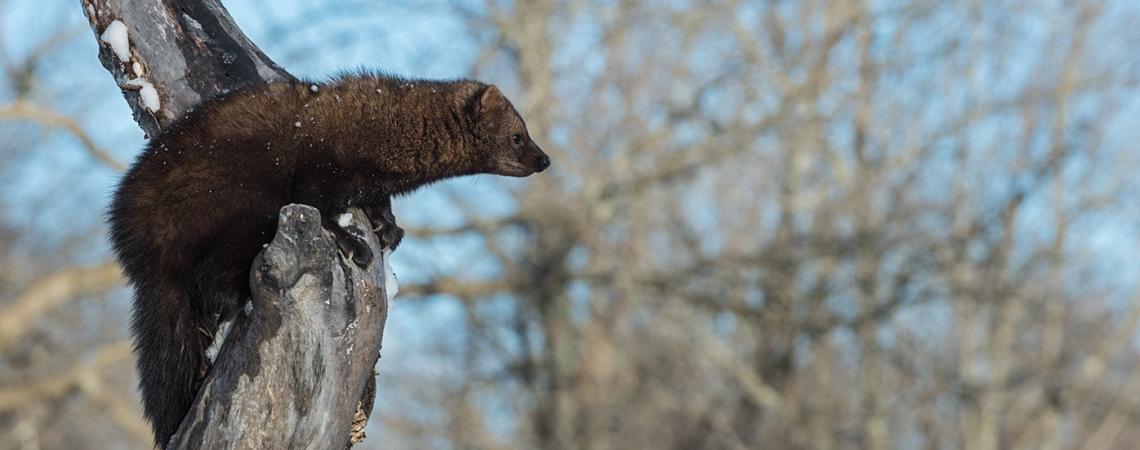A secretive, solitary hunter of the deep woods is attempting a comeback in the Buckeye State.
The fisher, a fur-bearing mammal found only in North America, is also known as black cat, black fox, or fisher cat because of its dark brown to nearly black coat.
Their name notwithstanding, they prey upon a variety of small mammals (not fish) as well as fruit, nuts, fungi, and carrion found in a forest habitat — today, predominantly in Canada and parts of California. Interestingly, the minor league professional baseball team in Manchester, New Hampshire — the Class AA affiliate of the Toronto Blue Jays — is named the Fisher Cats. But Ohio?
The fisher, a fur-bearing mammal found only in North America, is also known as black cat, black fox, or fisher cat because of its dark brown to nearly black coat.
“Fishers [have been discovered] in archaeological sites in Ohio, and they were found in Ashtabula County as late as 1837,” says John Harder, associate professor emeritus in evolution, ecology, and organismal biology at Ohio State University. “However, unregulated trapping and habitat loss led to the extirpation of fishers from the state by 1850.”
Fishers are not small. Males can measure 4 feet in length from nose to tip of tail and weigh as much as 15 pounds. Females are half that size.
They are also one of the few predators that actively target porcupines for food, where available. Possessing the same pugnacious, tenacious disposition found in other members of the weasel family, fishers begin their attack by viciously and repeatedly biting the docile porky on its face and head before flipping it on its back to reach its vulnerable underbelly, which has fewer protective quills.
An agile climber, the fisher is nearly unique in that it can descend a tree trunk headfirst. The name “fisher” may have derived from the fact that early colonists settling along America’s Eastern Seaboard saw a similarity between the fisher and the European polecat they remembered from their homelands, which was also called “fitch” or “fitchet.”
Ohio’s first modern-day fisher sighting was in 2013, according to Katie Dennison, a biologist with the Ohio Division of Wildlife, and since then, there have been 40 confirmed fisher observations across nine northeast Ohio counties: Ashtabula, Columbiana, Geauga, Trumbull, Mahoning, Lake, Jefferson, Harrison, and Tuscarawas. “Two-thirds of those sightings occurred in the last three years,” Dennison says. “Fishers are moving westward from established populations in Pennsylvania and naturally colonizing Ohio.”
Dennison says the Division of Wildlife collects Ohio road-killed fishers to determine age and test their genetics, and in February 2023, biologists collected two roadkill fisher carcasses from northeast Ohio — one of which was pregnant. Does that mean fishers are reproducing in Ohio and a population has reestablished itself? Not necessarily.
“The division anticipates that natural reproduction in fishers will be confirmed in the coming years, and may already be occurring,” Dennison says. “But as far as their population being reestablished, it’s a little too early to say for sure. Things definitely seem to be moving in the right direction.”
I’m all in favor of fishers returning to the Buckeye State, making our wild ecosystem one additional species stronger, and as a result more resilient.
Have you seen one?
The Division of Wildlife relies, in part, on public reports to monitor Ohio’s growing fisher population (as well as that of black bears, badgers, weasels, and bobcats). So if you live in northeast Ohio or happen to travel that direction, keep an eye out for these new critters. If you spot one, you can report your observations of those species (including photos or videos) to the Division of Wildlife via the HuntFishOH mobile app or at www.wildohio.gov. Please contact your county wildlife officer to report roadkill fishers — it is not permissible to collect roadkill carcasses yourself.
W.H. “Chip” Gross is Ohio Cooperative Living’s outdoors editor. Email him with your outdoors questions at whchipgross@gmail.com. Be sure to include “Ask Chip” in the subject of the email. Your question may be answered on www.ohiocoopliving.com!











